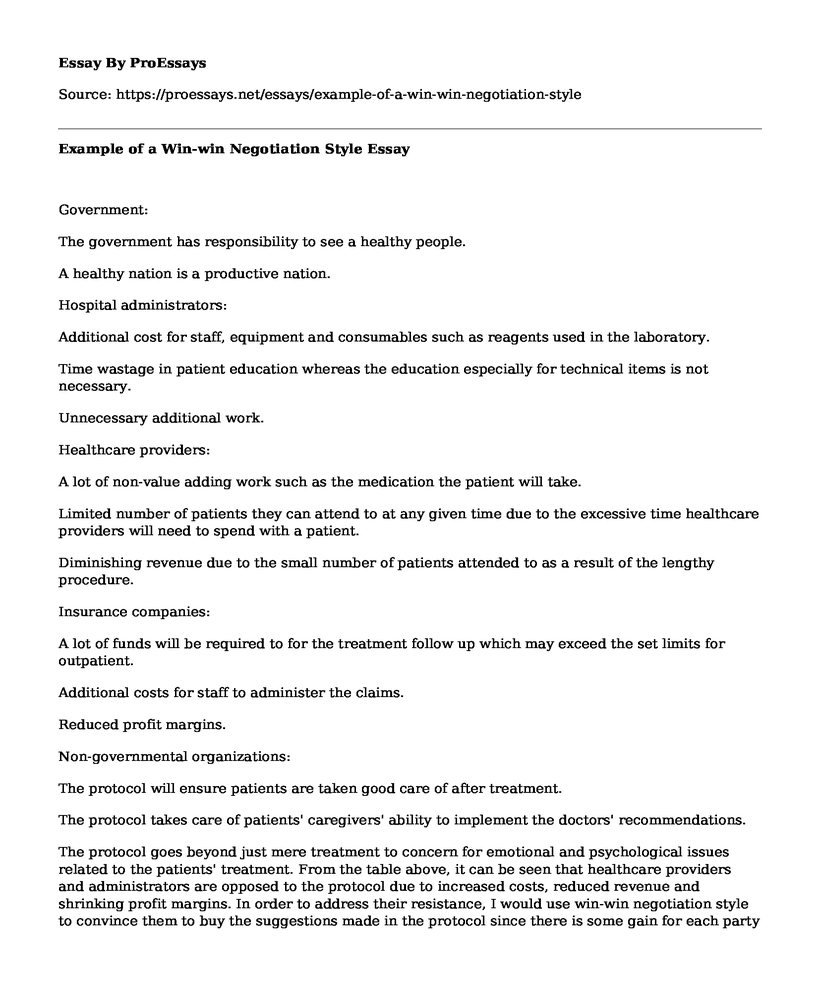Government:
The government has responsibility to see a healthy people.
A healthy nation is a productive nation.
Hospital administrators:
Additional cost for staff, equipment and consumables such as reagents used in the laboratory.
Time wastage in patient education whereas the education especially for technical items is not necessary.
Unnecessary additional work.
Healthcare providers:
A lot of non-value adding work such as the medication the patient will take.
Limited number of patients they can attend to at any given time due to the excessive time healthcare providers will need to spend with a patient.
Diminishing revenue due to the small number of patients attended to as a result of the lengthy procedure.
Insurance companies:
A lot of funds will be required to for the treatment follow up which may exceed the set limits for outpatient.
Additional costs for staff to administer the claims.
Reduced profit margins.
Non-governmental organizations:
The protocol will ensure patients are taken good care of after treatment.
The protocol takes care of patients' caregivers' ability to implement the doctors' recommendations.
The protocol goes beyond just mere treatment to concern for emotional and psychological issues related to the patients' treatment. From the table above, it can be seen that healthcare providers and administrators are opposed to the protocol due to increased costs, reduced revenue and shrinking profit margins. In order to address their resistance, I would use win-win negotiation style to convince them to buy the suggestions made in the protocol since there is some gain for each party although some compromise has to be made (Moore, 2014). As such, I would understand the interests of each party and invent areas of mutual gain. For example, the healthcare providers are not willing to take any additional expenses without any revenue in return. On the other hand, patients need quality healthcare at no extra cost. I would, therefore, advise the hospitals to church slightly above the standard rates for the extra care given and follow up after treatment to cater for the transport costs and consumables that are associated with the follow-up. In so doing, the healthcare facilities will cushion themselves against diminishing profit. Also, I would show them the advantages of the monitoring and full implementation of the protocol. For example, a happy customer is a source of future business in the form of repeat visits and referral for other patients. In order to convince the patients to accept the extra pay, I would show them the essence of paying by discussing the tradeoffs that exist between quality, time and cost since all cannot exist without compromising on some things. For instance, I would inform them that quality is expensive.
On the contrary, I would use the win-lose strategy (Martin, 2016) to woo the insurance companies consent to the protocol. In this case, I would require the patients to pay more premiums for the health insurance to cater for the extra services they would get from the medical practitioners and related staff. This strategy is more appropriate since the health insurers are more dominant in the negotiation as opposed to the patients. The patients are interested in reducing medical bills and getting affordable quality health care, and the only way to achieve without more financial strain is taking a medical cover. On the contrary, the medical cover providers want to make a profit out of the patients condition. Since I know health insurance is not an option but a must for the patients, I would advise health insurers to increase premiums. However, there would be some gain in the form of quality healthcare for the patients, and so this would not be a perfect win-lose situation.
References
Martin, S. (2016). Communication Strategies for Trade Negotiations: a practical guide.
Moore, C. W. (2014). The mediation process: Practical strategies for resolving conflict. John Wiley & Sons.
Cite this page
Example of a Win-win Negotiation Style. (2021, Apr 01). Retrieved from https://proessays.net/essays/example-of-a-win-win-negotiation-style
If you are the original author of this essay and no longer wish to have it published on the ProEssays website, please click below to request its removal:
- Case Study on Joe and Bill Battle of Interest
- Strategic Alternatives to Diversification - Essay Sample
- Essay Sample on System Security Plan: An In-Depth Guide to Accreditation & Certification
- Paper Example on Madam Sindah's Bitter, Unprofessional Tone: Impact on Communication
- Essay on Strategic Organizational Development: Information Management Key to Knowledge Mgmt Systems
- Project Management: Maximizing Quality - Report Example
- Implementing Policy in the Health Care System







